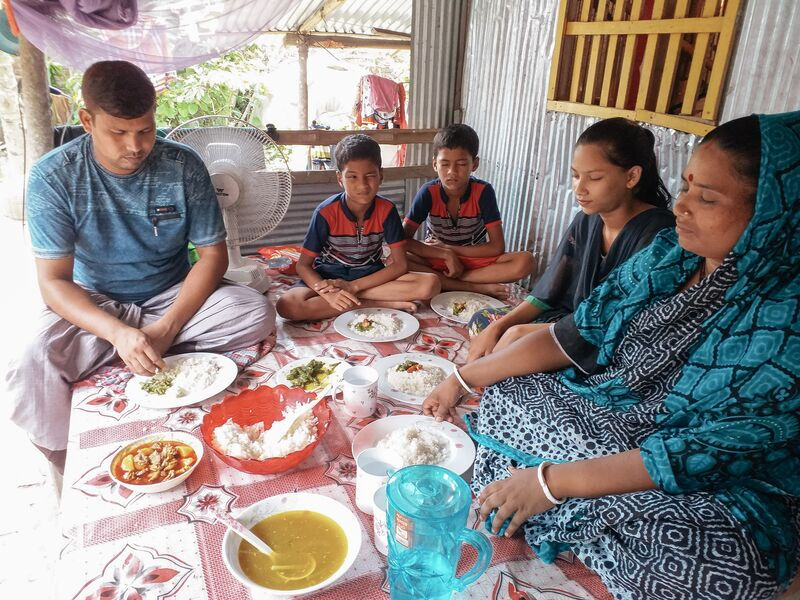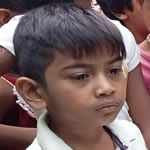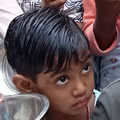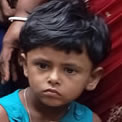Kichri in Bangladesh: Power of Compassion & Unity in Food
- David Burgess
- Aug 20, 2024
- 6 min read
Key Takeaways
Kichri, a simple rice and lentil dish, is a beloved comfort food in Bangladesh, especially during the monsoon season.
This dish is deeply rooted in Bangladeshi culture and is often associated with rainy days and family gatherings.
Traditional Bangladeshi kichri is made with rice, lentils, and various spices, often accompanied by side dishes.
Kichri plays a significant role in religious festivals and community meals, symbolizing unity and compassion.
Different regions in Bangladesh have their own unique variations of kichri, reflecting the country’s rich cultural diversity.

Lotus Ministry Unites A Community In Bangladesh With Kichri
Taste of Compassion: The Uniting Power of Kichri in Bangladesh
Introduction to Kichri: A Symbol of Unity
Kichri, also known as khichuri, is more than just a dish in Bangladesh; it’s a symbol of unity and comfort. This simple yet hearty meal, made primarily from rice and lentils, brings people together, its warm, nourishing qualities are most appreciated.
Imagine a rainy day in Bangladesh, the sky overcast and the air filled with the soothing sound of raindrops. Families gather around the dining table, eagerly awaiting a steaming pot of kichri. It’s a scene of togetherness, where the simplicity of the dish reflects the warmth of familial bonds.
History and Cultural Significance of Kichri
The history of kichri dates back centuries, with its roots deeply embedded in South Asian cuisine. In Bangladesh, kichri is not just food; it’s a cultural emblem. This dish transcends socio-economic boundaries, being enjoyed by both the wealthy and the poor.
Historical records suggest that people in the region have been consuming rice and lentils since ancient times. Renowned Moroccan explorer Ibn Battuta, in the 14th century, documented the widespread consumption of a dish made from rice, mung beans, and butter in South Asia.
"There's an incredible variety of khichri," says Colleen Taylor Sen, an expert on Indian cuisine. "And almost all of them have recipes for khichri."
Origins of Kichri in Bangladeshi Cuisine
In Bangladesh, kichri is particularly cherished during the monsoon season. The dish is often associated with rainy days, when its warmth and simplicity provide comfort against the chill and dampness. My friends from Bangladesh fondly recall their childhood memories of enjoying kichri during these rainy spells.
One of the unique aspects of Bangladeshi kichri is its versatility. It can be a simple, everyday meal or a more elaborate dish served during special occasions. The basic ingredients—rice and lentils—are staples in Bangladeshi households, making kichri a practical and accessible dish for all.

A Traditional Bowl Of Kichri
Traditional Ingredients and Preparation Methods
Traditional Bangladeshi kichri is made with a few key ingredients:
Rice
Lentils (often mung dal)
Turmeric
Ginger
Green chilies
Bay leaves
Asafoetida
The preparation process is straightforward yet requires attention to detail. First, the rice and lentils are washed and soaked. Then, they are cooked together with spices until they reach a creamy consistency.
Besides the basic recipe, kichri is often accompanied by side dishes that enhance its taste and nutritional value. Popular accompaniments include a variety of spicy spreads known as bhorta.
Learn more about Bangladesh kichri variations & regional recipes.
Kichri in Festivals and Celebrations
Kichri holds a special place in Bangladeshi festivals and celebrations. During religious events, such as Durga Puja, a special version of kichri called bhog-er khichuri is prepared and offered to the deities. This version is typically richer, with added vegetables and ghee.
Community meals are another occasion where kichri shines. In rural areas, it’s common for villagers to come together and cook a large pot of kichri, which is then shared among everyone. This practice fosters a sense of community and mutual support.
The Power of Compassion Through Kichri
Kichri is more than just a meal; it’s a manifestation of compassion and empathy. In Bangladesh, the tradition of cooking and sharing kichri during times of crisis, such as natural disasters, is a testament to its role in fostering community solidarity. The simplicity of its ingredients makes it easy to prepare in large quantities, ensuring that everyone has access to a warm, nutritious meal.
During the monsoon season, when many areas are prone to flooding, kichri becomes a lifeline for affected communities. Volunteers and aid organizations often distribute kichri to those in need, demonstrating the power of food to bring comfort and hope in challenging times.

Lotus Ministry Sharing In The Community
Community Meals and Sharing Traditions
In rural Bangladesh, community meals are a common practice, and kichri often takes center stage at these gatherings. Villagers come together to cook a large pot of kichri, which is then shared among everyone. This communal cooking and eating experience strengthens social bonds and reinforces a sense of unity.
Besides the nutritional benefits, these community meals provide an opportunity for people to connect, share stories, and support one another. The act of sharing a simple yet hearty meal like kichri highlights the importance of togetherness and mutual care.
Role of Kichri in Social Events
Kichri plays a pivotal role in various social events in Bangladesh. From religious ceremonies to family reunions, this versatile dish is a staple. Its ease of preparation and ability to feed large groups make it a popular choice for hosts looking to provide a wholesome and satisfying meal for their guests.
Moreover, the tradition of serving kichri at social events underscores the cultural significance of the dish. It’s not just about the food; it’s about the shared experience and the memories created around the dining table.
Impact of Cooking and Sharing Kichri on Social Bonds
The process of cooking and sharing kichri has a profound impact on social bonds. In many Bangladeshi households, preparing kichri is a collaborative effort, with family members contributing to different aspects of the cooking process. This teamwork fosters a sense of unity and cooperation.
Sharing kichri with neighbors and friends further strengthens these social ties. It’s a gesture of goodwill and hospitality, reflecting the values of generosity and community spirit that are deeply ingrained in Bangladeshi culture.
Unity and Diversity Reflected in Kichri
Kichri is a dish that beautifully reflects the unity and diversity of Bangladesh. While the basic recipe remains the same, different regions have their own unique variations, showcasing the rich cultural tapestry of the country. This diversity within a single dish symbolizes the broader cultural unity that defines Bangladesh.
Whether it’s the addition of local spices or the inclusion of regional vegetables, each version of kichri tells a story of its own, highlighting the distinct culinary traditions of various communities.
Regional Variations of Kichri in Bangladesh
Bangladesh is home to a variety of regional kichri recipes, each with its own unique twist. These variations not only add to the culinary richness of the country but also reflect the diverse cultural influences that have shaped Bangladeshi cuisine over the centuries.
Sylheti Kichri
Sylheti kichri, originating from the Sylhet region, is known for its distinctive flavor and texture. This version often includes a mix of aromatic spices like cinnamon, cardamom, and cloves, giving it a rich and fragrant profile.
Chittagonian Kichri
In the Chittagong region, kichri takes on a different character. Chittagonian kichri is usually spicier, with the addition of green chilies and other local spices. This version is often cooked with coconut milk, which adds a creamy texture and a subtle sweetness to the dish.
Kichri as a Symbol of Cultural Blend

"Sponsored Kids In Bangladesh Share ..." from onechild.org
Kichri is a dish that beautifully reflects the unity and diversity of Bangladesh. While the basic recipe remains the same, different regions have their own unique variations, showcasing the rich cultural tapestry of the country. This diversity within a single dish symbolizes the broader cultural unity that defines Bangladesh.
Whether it’s the addition of local spices or the inclusion of regional vegetables, each version of kichri tells a story of its own, highlighting the distinct culinary traditions of various communities. This blend of flavors and traditions within a single dish mirrors the harmonious coexistence of diverse cultural influences in Bangladesh.
Conclusion: Embracing Unity Through Food
Kichri in Bangladesh is much more than a simple meal; it is a powerful symbol of compassion, unity, and cultural diversity. The act of cooking and sharing kichri brings people together, reinforcing social bonds and promoting a sense of community. Through its various regional adaptations, kichri showcases the rich cultural heritage of Bangladesh, celebrating the unique flavors and traditions that define the country.
In a world where division often dominates, the humble kichri serves as a reminder of the power of food to unite us. By embracing the values of generosity, empathy, and togetherness embodied in this dish, we can foster a more compassionate and connected global community.
"There's no doubt that the Egyptian koshary's ancestor is in fact the Indian khichri," says Wright. The name and the ingredients are similar, he says. And khichri "is similar to mujaddara (another Middle Eastern comfort dish with rice and lentils), which can be traced back to the 10th century."
So, next time you enjoy a bowl of kichri, remember its rich history and the cultural unity it represents. Let it inspire you to appreciate the diverse culinary traditions around the world and the shared human experiences they reflect.
Frequently Asked Questions (FAQ)
Why is Kichri so important in Bangladeshi culture?
Kichri is important in Bangladeshi culture because it symbolizes unity, compassion, and cultural diversity. It is a dish that brings people together, especially during the monsoon season and various festivals. Its simplicity and nutritional value make it accessible to everyone, reinforcing social bonds and promoting a sense of community.
How does Kichri unite different communities in Bangladesh?
Kichri unites different communities in Bangladesh by serving as a common dish that transcends socio-economic boundaries. During festivals, community meals, and times of crisis, kichri is often prepared and shared among large groups of people. This practice fosters a sense of togetherness, mutual support, and cultural unity.











Comments